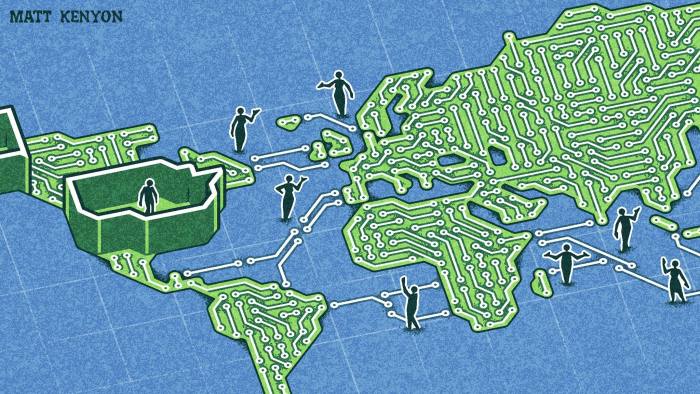
At different stages in modern world history, different nations had held the position of technological leadership. Gradually, lagging nations play catch-up with the technological leader through imitation and other means. Realizing their losing technological edge, the technological leaders in the past have adopted several strategies to block the diffusion of technology. During the Cold War, the United States and its allies raised a technological barrier against the Communist bloc through the Coordinating Committee for Multilateral Export Controls (COCOM). In the 1980s, the United States was losing competitiveness in the memory chip (DRAM) segment of the semiconductor sector to the Japanese firms. Realizing the national security importance of DRAMs, the federal government facilitated the formation of SEMATECH- a consortium of American semiconductor firms, with $100 million in R&D funding each year. Around the same time, when the Japanese firms nearly wiped out all the US LCD screen makers, the federal government jumped in to help the American firms by forming another consortium called ADMARC.
As the threat from Japan dissipated, the United States is currently looking at China as a threat to its technological leadership status. China, at present, is a market economy, in all but name. There are huge western investments inside China, which makes dissipation of know-how to this country much easier than it was during the Cold War times. In the last decade, China has also emerged as a global R&D destination for multinational companies, including American headquartered multinationals like IBM, Motorola, and Microsoft.
Since 1979, China has recognized advances in Science and Technology (S&T) to be the key to sustained economic growth. Keeping it in mind, China has taken several steps to make rapid advances in S&T. The government has sent its bright minds to study abroad immediately after opening up to the outside world. In recent years, it has taken active steps to bring these people back to their homeland by offering them various incentives. Since 1998, China has invested heavily in higher education focused mainly towards cultivating a large domestic workforce in Science, Technology, Engineering, and Mathematics (STEM) fields. This investment is bearing fruit now with China’s rapid rise in the number of registered patents by its companies, and scientific papers published by its scholars. To reduce its reliance on foreign technologies, China has announced the 15-year ‘Medium- and Long- Term Plan for Science and Technology Development’ in 2006. This plan and the ‘Made in China 2025′ plan announced in 2015 has drawn criticism from the United States for its forced technology transfer, state-backed mergers, and acquisitions (M&A), and cyber and industrial espionage.
Within the US government, Congress has always been wary of the threat from China. The Congressional response to the Chinese technology challenge is, however, drawn from the Cold War playbook. The Congress passed the Foreign Investment Risk Review Modernization Act (FIRRMA) in 2018 to strengthen the Committee on Foreign Investments in the United States (CFIUS), which would enable it to block deals that could pose a threat to US edge in “critical technologies.” FIRRMA also amended the Cold War era Export Administration Act with a new Export Control Reform Act. The reform act mandates the US Department of Commerce to identify and protect “emerging and foundational technologies” that are not otherwise covered by the US export control regimes.
In addition to the legislation, Congress has shown a special interest in this matter, discernable from the number of committee hearings focused on the issue of technological competitiveness. In one particular hearing before the Senate Intelligence committee in February 2018, the FBI director Christopher Wray stated that Confucius Institutes are “just one of many tools that [China] take[s] advantage of” to monitor developing technologies in the United States. This statement particularly had repercussions as it led to the actions by numerous colleges and universities to close down Confucius institutes operating on their campuses.
The appendage “non-traditional” information collectors have been used frequently by the Trump administration to refer to Chinese students, faculty, and scientists in the US colleges and universities. Consequently, a new visa policy was introduced last year to restrict entry to Chinese students. The students most affected by visa restrictions were those applying to science and technology fields, including aviation, robotics, and high-tech manufacturing. In recent years, Chinese-born faculties working in US universities have also come under the scanner of law enforcement officials for their alleged involvement in technology stealing.
Thus, waking up to the impending threat from China to its technological competitiveness, the United States has adopted various measures to plug the leakage of critical technologies to China. In today’s globalized world, all these measures are likely to fall short of achieving its intended goal. As technology diffusion is a two-way process, shielding the domestic innovation ecosystem from the Chinese would not benefit the United States in the long run. This prediction appears likely in the event of recent advances that the Chinese are making in future technologies, including Artificial Intelligence (AI), next-generation mobile telephony, and clean energy. Therefore, the best option for the United States is not technological protectionism under the guise of national security (i.e., techno-security), but through increased government R&D support for basic and industrial research, focus on higher education in S&T fields, and open immigration policy that would enrich the domestic innovation ecosystem.
*** The author is Doctoral Scholar, Centre for Canadian, U.S. & Latin American Studies (CCUS&LAS), Jawaharlal Nehru University, New Delhi. ***
![]()

